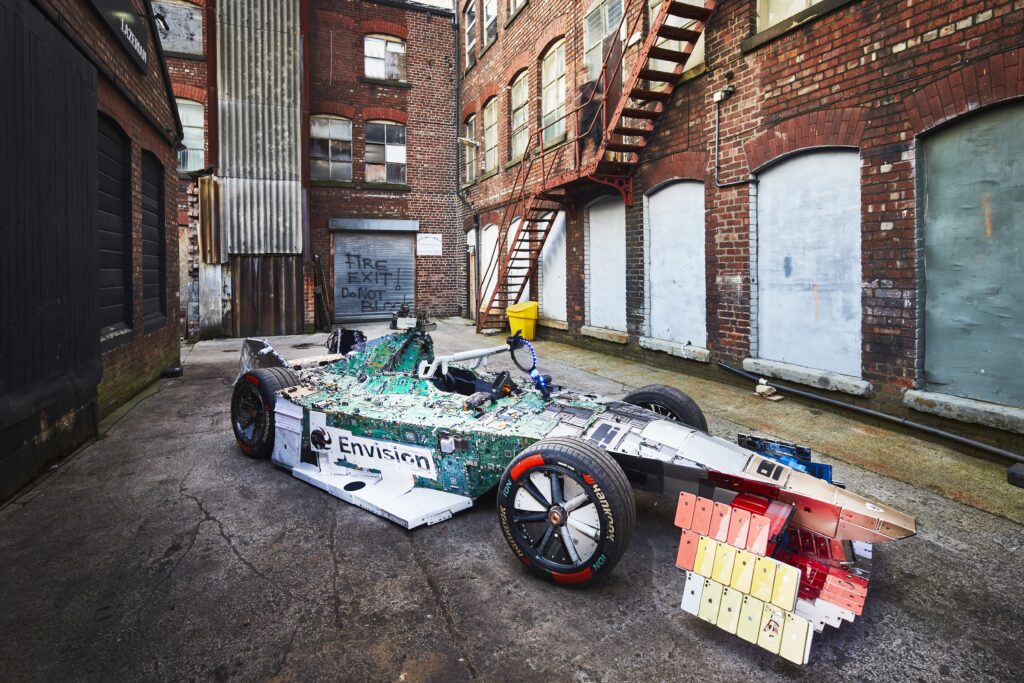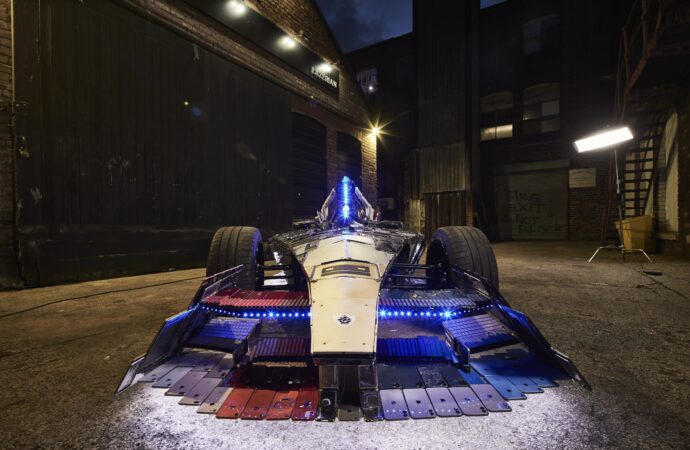Formula E Season 9 champion Envision Racing and artist Liam Hopkins bring the growing issue of e-waste to life through the Recover E initiative
Two years after crafting a scale-sized replica of a Formula E Gen 2 car entirely from single-use plastic, Liam Hopkins shifted his focus to e-waste, engineering a drivable Gen 3 car using discarded laptops, smartphones, games consoles, monitors, cables and wires.
With the backing of Envision Racing, the reigning champion of Formula E Season 9, the Manchester-based artist and designer dedicated an entire year and utilised tens of thousands of discarded electronic items, even repurposing the motor and rear axle from an electronic beach buggy. This remarkable effort not only brought a drivable creation to life but also highlighted the pressing concern of e-waste.
Unfazed by challenges encountered while crafting the car’s chassis and body, Hopkins remained resolute in his commitment to ensure that each component of his creation had a prior functional existence.
“I wanted the car to have a narrative, so you can look at it and say, ‘Yes, cool, it’s made out of waste, but there’s a story there,’” explains Hopkins. “Right where the Envision logo is, you look inside, and it’s lit up and you can see all these internals and you notice that that part is all made from hundreds of old cameras from within smartphones. I want it to hit home when the driver is sat there.
“We’ve got the halo made up from a PlayStation tennis racket, then it comes up to a VR headset, and then we have Nintendo Wii baseball bats and shotguns. So you sit in the driver’s seat and you’re surrounded by these objects and you see that we’ve created this huge amount of rubbish that really needs to go on to have another life, rather than just be hidden away or put in the ground.”
The revealed and driven final product at the ExCeL centre in London, with UNEP ambassador Aidan Gallagher behind the wheel prior to the Formula E season finale, was impressive. However, the underlying message of the car carries substantial importance.
E-waste, the swiftly expanding category of discarded electronics, is now the fastest-growing waste stream, generating 50 millions tonnes annually. If the current trajectory remains the same, this figure could surge to 120 million tonnes by 2050. This category encompasses a wide range of items, such as mobile phones, laptops, tablets, electronic vapes, televisions and other household electronics.
Electronic items often pose greater environmental harm compared to domestic waste and single-use plastics (which were highlighted by Envision and Hopkins in 2021), with their production contributing significant carbon emissions to the atmosphere (with each smartphone averaging 93kg of CO2e emissions). They also frequently contain rare minerals and metals that have to be mined at a huge environmental cost.
To magnify the initiative’s impact, Envision and Hopkins introduced the ‘Recover E’ competition, inviting global youth to craft their own Formula E car from e-waste.
Inspired by Hopkins’ creation, this worldwide competition spanned three age brackets: 9-11 years, 12-16 years, and 19-21 years. Participants were challenged to construct miniature Formula E race cars using discarded e-waste. Notably, each submission led to Envision Racing committing to planting a mangrove tree in Madagascar.
For Hopkins, engaging young individuals in the Recover E initiative holds significant value. He believes that infusing a youthful and playful approach into design and education could serve as a catalyst for shaping better and more sustainable products in the future.
“One thing I wanted to get across with this vehicle was that we all need to go back and play a bit more. Being able to not worry, take things apart and see how they’re made and see if they can be repaired,” he says. “As humans, we learn so much through play in our early years growing up, and then it goes to further education where the fun comes out of it. We end up living in a very serious place. If you think back to school, you learn so much more from a fun teacher. So, if we can make things more fun and more engaging, then people take it in naturally and are excited.

“This project is about putting the question to the viewer, ‘Why is there a Formula E car made of rubbish?’ And then you can say to them, ‘There’s an iPhone from two years ago; there’s a vape that was used a week ago; there’s your granddad’s old radio sat on top.’”
Hopkins also wants Recover E to inspire children around the world to think about what they enjoy doing, and potentially one day encourage the next generation of engineers and designers. He sees it as the key to improving how electronic goods are produced and working towards a circular economy that benefits consumers and the planet alike.
“The younger generations are used to playing with games consoles and these electronic goods, and there will be jobs around designing these objects, and if they’re designed better and in a way that encourages people to take them apart and repair them, then I’ve done my job.”
However, addressing this challenge extends far beyond the responsibility of young people; it demands a dual approach involving both consumers and producers. Companies like BT are attempting to pioneer changing habits by leasing out items like television boxes and wifi routers, enabling customers to return them post-contract for refurbishment and reuse.
At the Race Against Climate Change event, hosted by Envision, Matthew Manning, head of circular economy at BT, underscored the company’s shift towards prioritising the reuse and recycling of goods.
“An opportunity that we have as a telecoms provider is, if someone is changing their phone, for example, getting that old device back. Phones are one of those common devices that tend to be hoarded away, be it over data concerns, or people don’t know what to do with them,” he says. “Last year, we got about 190,000 phones back and 97% of those are reused, and a small percentage of them can go on to be recycled.”
Initiatives like Recover E aim to heighten our collective awareness of dormant electronic items in our homes, shining a spotlight on the escalating concern of e-waste. As the issue gains the attention it warrants, it holds the potential to drive shifts in attitudes and policies on both national and international scales, fostering broader transformative change.
Opt into our weekly newsletter for exclusive content focused on sustainability strategy, communication and leadership for sport’s ecosystem.










Leave a Comment
Your email address will not be published. Required fields are marked with *